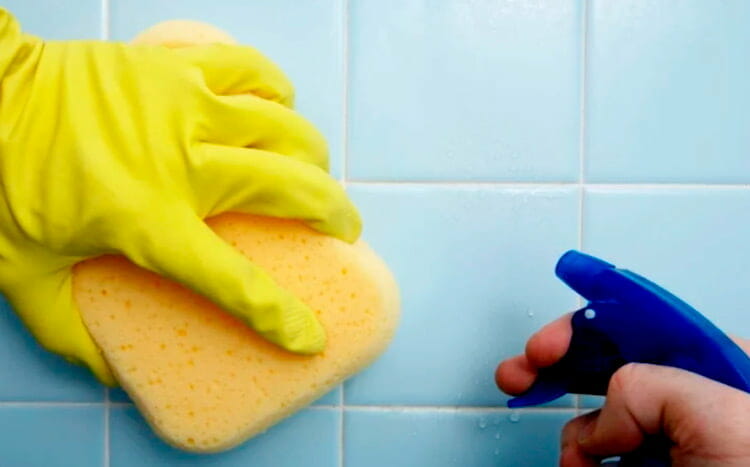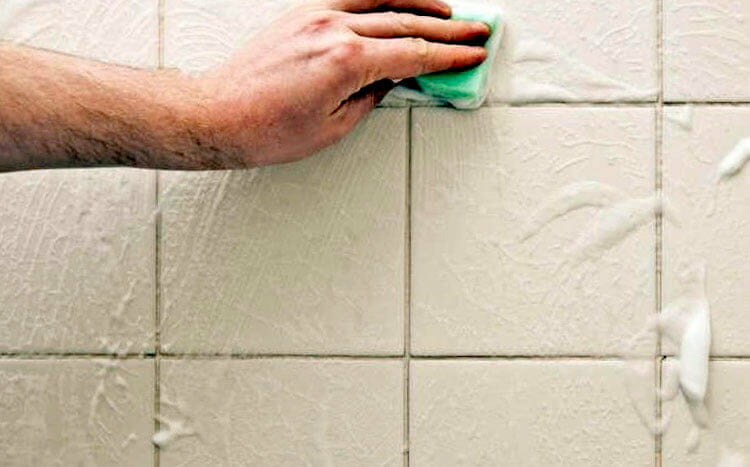Your restroom probably endures the highest humidity in your household. Due to the ceaseless presence of water, it becomes a perfect breeding ground for the expansion and spread of mold and mildew.
If these fungi are giving you a headache, you should contact a mold removal expert immediately. On average, you can spend between $500 and $1,500 for the entire project.
What we cover
ToggleAverage cost of bathroom mold removal
Many homeowners in the country spend around $900 for bathroom mold removal. This price covers the labor and materials costs.
You might also spend more depending on the size of your bathroom, the type of mold in the bathroom, and the extent of the infestation.
Most contractors will charge you $75 – $120 per hour for their labor, but you might still find a few who charge $5 to $15 per linear foot.
| Service | Quantity | Low | High |
|---|---|---|---|
| Bathroom mold removal cost | per sq. foot | $5 | $15 |
| Bathroom mold materials cost | 40 sq ft | $320 | $680 |
| Bathroom mold removal labor cost | Per hour | $75 | $120 |
| Total average (40 sq ft. bathroom) | 40 sq ft | $520 | $1280 |
Average Bathroom Mold Removal Estimate: $900
Price factors that will impact cost
Other factors that will influence your total expenditure for the project will include:
Cost of mold testing – Before any remediation process, most experts opt to conduct mold tests to confirm the type of mold in your bathroom. This information then guides them on how to deal with it. You can spend between $300 to $900 extra on this.
Hiring pros or DIY – Hiring experts for the remediation project is usually more expensive than doing it as a DIY. If you know your way around mold remediation, you can significantly cut down your costs.
Cause of the mold – If the mold infestation was caused by a leaking tap, roof, or poor insulation, you’ll spend a lot more on repairs.
Damages and restoration – Replacing the surface structures that the mold may have compromised obviously increase your costs.
Home insurance – While most home insurances don’t cover mold remediation, if you live in an area that’s prone to flooding, you can easily find insurance that covers at least a part of the remediation costs. This helps bring the prices down.

Types of bathroom mold
As you probably know, there are over 300,000 types of molds in the environment. Of these types, there are several molds that are fairly common in the bathroom. This includes the Aspergillus, Penicillium, Cladosporium, and black mold.
They mainly appear dark grey, green, blue, and sometimes brown making them quite easy to distinguish. The Aspergillus mold is the most likely to appear in your bathroom.
If you don’t spot these stains, other common molds you’ll find include:
Pink bathroom mold
When cleaning your bathroom, you might also come across some pink fuzzy patches and stains on the walls. These are known as the pink bathroom mold.
Despite their name, pink molds aren’t actual mold. They’re, in fact, a type of water-borne bacteria known as Serratia Marcescens, which can also appear within red-pigments, or orange.
The good thing about them is that they’re easy to spot and clean.

Black bathroom mold
Another common mold is the black mold. Known by many to be a dangerous and infectious mold, you have to be careful when dealing with it. It appears as a green-black patch that’s common under the showers, sinks, and bathtubs.
Dealing with this mold can be harder and more costly since you might need to spend extra cash on mold testing to ascertain the mold type.
Removing mold from showers
Mold under your shower appears like dark or greenish patches depending on the type of mold. Once you’re sure which type of mold it is, here are some steps you can try to remove the mold:
Step 1: Gather your supplies
Find all the chemicals and tools you’ll need for the job. This may include bleach, white vinegar, a spray bottle, and a course-pad brush. You’ll also need some protective gear such as a face mask, gloves, and eye protection gear since the chemicals you’re using might be toxic.
Step 2: Mix bleach with water and spray
Take some bleach and mix it in water to form a solution. Put the bleach solution into a spray bottle, then spray all the affected areas on the shower. Leave the solution on the moldy surface for about half an hour, and scrub it out using your coarse brush. Use warm water to rinse it. If you choose to use vinegar, the steps are still the same.
Step 3: Use a dry towel to dry cleaned areas
Find a dry towel or piece of cloth and use it to dry the clean areas.

How to remove black mold from shower grout
Your bathroom tile grout is usually the most mold-infested area in your bathroom. There are different ways you can address the situation, e.g., you can use bleach, vinegar, sodium peroxide, and even salt.
Using baking soda
Step 1: Assemble your supplies
To successfully complete the job, you’ll need baking soda, a spray can, cloth, and a brush or toothpaste. You should also always ensure that you have your protective gear on.
Step 2: Mix baking soda and water, then spray
Now mix your baking soda with water and then spray it on the infested areas using a spray bottle. Next, wait for around 30 minutes, then rinse the surfaces with warm water. If the grout is very dirty, you can wait for an hour or two before rinsing.
Alternative: Use baking soda paste
Instead of making a baking soda solution, you can also make a paste from the baking soda and apply it to the moldy grouts. Let it sit for about 10 minutes, then scrub the paste with a soft brush. Finally, rinse with water and repeat the process until the grout is clean.
Using Vinegar
Step 1: Protect yourself
Ensure you have your protective gear on (gloves, face mask, and eye protection gear).
Step 2: Mix and spray the vinegar solution
Mix equal amounts of the white vinegar with water in a spray bottle, then give it around half an hour to settle on the infected surface, then gently scrub it. Your last step will be rinsing the surface and repeating it until it’s clean.
Using Bleach
Step 1: Get your supplies
Confirm you have all the requisite tools to start cleaning your bathroom grout. Ensure you have a bleach (chlorine), gloves, spray bottle, face mask, a brush, and toothbrush.
Step 2: Mix bleach and spray it
Mix the bleach and water in a 1:4 ratio, then use a spray bottle to spread the solution to all the mold-affected areas. Wait for 30 minutes, then use a brush to scrub vigorously and rinse with cold water. Repeat the processes for the best results.
Alternative: Scrub bleach directly
Instead of mixing your bleach with water, you can also scrub bleach directly on the grout using an old toothbrush. Allow the bleach to settle on the grout for around 30 minutes, then rinse it with warm water.
Keep in mind: Using bleach can cause fading and discoloration of your colored tiles.
Use Hydrogen Peroxide
Step 1: Get your supplies
You’ll need to have hydrogen peroxide, baking soda, white flour, and protective gear for yourself like gloves, respiratory mask, and eye protection.
Step 2: Make a Hydrogen peroxide paste
Start by mixing the hydrogen peroxide with white flour until it becomes a paste. Apply that paste to the moldy grout in your bathroom and let it sit overnight, then rinse it with cold water.
Alternative: Use hydrogen peroxide with baking soda
Make a baking soda paste (as explained above), then apply it over the moldy grout. Next, pour the hydrogen peroxide paste over the baking soda paste until it starts fizzing. Now use a coarse brush to scrub the grout and rinse it with water. Repeat the process for best results.
Removing black mold from bathroom silicon
There are two main ways to remove mold from the bathroom silicone; Using vinegar and baking soda and using bleach.
Using vinegar and baking soda
Step 1: Gather your tools
You’ll need some white vinegar, bleach, baking soda, damp rag, coarse-bristle brush, wet sponge, and protective gear.
Step 2: Create a Vinegar and baking soda paste
Mix vinegar and baking soda in a 1:3 ratio, then rub the paste onto the silicone sealant with a thick layer and let it settle for around 5 minutes.
Step 3: Scrub and rinse
Use your course-bristled brush to scrub over the paste, then rinse the spot with cold water and a wet sponge. Repeat this until there’s no remaining mold.
Using bleach
Step 1: Mix bleach with water
Mix bleach and water in a 1:2 ratio, then apply or spray it to your silicone sealant and leave it to evaporate.
Step 2: Clean and Rinse
Use a wet cloth or sponge and cold water to clean and rinse the sealant, then use a dry cloth to dry the silicone sealant.
Should I hire a professional mold removalist?
Yes! While it’s possible to DIY your bathroom mold removal job, there are tons of reasons why you should opt for a professional. Among the key reasons to hire an expert includes:
Guarantee for a better job –
Even if you read a thousand DIY mold removal articles, you’ll never do as good as an experienced and well-trained removal expert. The knowledge and modern techniques employed by experts today guarantee you a thorough cleaning. Once the job is complete, you can be sure that molds won’t find their way back to the bathroom.
Experts do it faster –
In case you didn’t know, mold grows and spreads within a span of 24 – 48 hours. Therefore, every day you waste doing the job yourself, millions of molds may be spreading all around the house. An expert can complete the mold removal job in your bathroom within a day or two.
Proper assessments and Action plan –
Dealing with molds effectively requires having a well-detailed action plan. Hiring an expert will help you create an action plan that’s both safe and effective for your bathroom. This ensures you not only kill the mold; you’ll also ensure it can never grow back in your bathroom.
Hiring is safer –
Every time you choose to interact with the molds in your bathroom, you expose yourself to many mold spores, which may later come to affect your health. Experts are always in their right protective gear and know-how to complete the job safely. They might also have insurance covers against mold accidents.
These are but a few of the reasons why you should hire a professional for your mold removal project.
Tired of searching for mold removers?
Use our FREE service! With HomeGardenGuides.com, you are quickly matched with top-voted local Mold Inspection and removal Specialists in just two easy steps!
You can get 3 estimates fast by real certified experts in your area in just 2 minutes.
- Scroll to the top of the page and enter your Zip code.
- Answer questions about your mold job
- Your details are forwarded to three local experts. They will send you a price estimate for the job and some friendly advice.
IMPORTANT: There is no obligation to hire any of these mold removal experts. This is a free tool and service to be used at your pleasure.
FAQ's
Is bathroom mold dangerous?
Yes! According to the Centre for Disease Control (CDC), every type of mold is dangerous for your health – even bathroom mold. With high infestation rates, these molds can result in allergic reactions like nausea, wheezing, coughing, and itchy eyes.
Bathroom mold can also increase the chances of infection among people with severe breathing problems.
Can you get sick from bathroom mold?
Yes! As aforementioned, living in a house with bathroom molds results in allergic reactions such as nasal congestion, coughing, skin rashes, sneezing, and running nose, among other symptoms.
People with lower immunity and respiratory disease might also experience increased infection rates.
Does bleach kill bathroom mold?
Not all of it! Bleach has been in use for many years to kill mold from homes. However, most manufacturers hide the fact that bleach isn’t as effective at killing mold as they advertise.
Bleach can only kill the mold growing on the surface of different materials. Therefore, if mold eats its way through a porous material like wood and concrete, bleach will only kill the surface molds.
White vinegar, on the other hand, has proven to be very effective at killing mold compared to bleach. It can access spores hidden in the porous surfaces and kill mold from their roots.
Should I install a fan to prevent bathroom mold from returning?
Yes! Fans can be really helpful tools for improving ventilation in your bathroom. It ensures that moisture doesn’t remain stagnant in the bathroom, providing damp surfaces for molds to grow on.
Nonetheless, having a bathroom fan can also do more harm than good. For instance, if not correctly installed, the fan will drive the bathroom moisture to other parts of the home.
This means more expenses to remove mold from the house. Moreover, the fans will only be effective if the person in the bathroom has switched it on. If anyone forgets, it could attract more mold growth.
However, if you don’t have a bathroom fan, always ensure the window is open when you’re taking a shower, and you’ll be okay.














